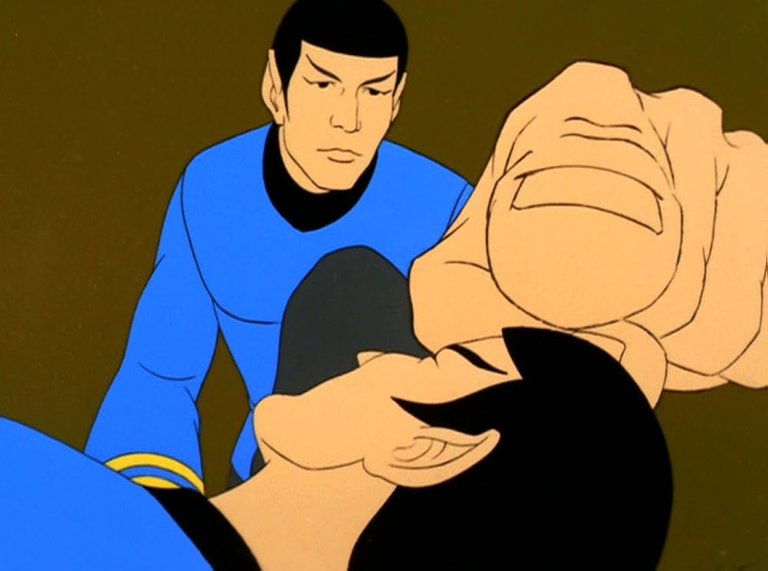Television Review: The Infinite Vulcan (Star Trek: The Animated Series, S1X07, 1973)

The Infinite Vulcan (S01E07)
Airdate: October 20th 1973
Written by: Walter Koenig
Directed by: Hal Sutherland
Running Time: 22 minutes
Star Trek fandom has long revered not only the imaginative worlds and technologies of the franchise but also its characters and the actors who brought them to life. This reverence became evident early on, particularly when Pavel Chekhov, a beloved regular in Star Trek: The Original Series (TOS), was notably absent from Star Trek: The Animated Series (TAS) due to budget constraints. Fans, deeply attached to Walter Koenig’s portrayal of the young ensign, felt his exclusion keenly. Gene Roddenberry, reportedly sensitive to this disappointment, offered Koenig a creative compromise: the chance to write an episode of TAS. The resulting script, The Infinite Vulcan, became a significant milestone in Trek lore as the first instance of a main cast member contributing as a writer. While the episode’s historical significance is undeniable, its execution and lasting impact remain subjects of debate.
The plot of The Infinite Vulcan begins with the USS Enterprise surveying the newly discovered planet Phylos, a world under consideration for Federation colonisation. During an away mission, Hikaru Sulu is critically injured after being stung by a venomous plant called a retlaw. The crew is saved by the Phylosians, a reclusive, plant-like sentient species whose advanced medical technology revives Sulu. The Phylosians explain that their civilisation was nearly eradicated by Dr. Stavros Kenicilius, a human scientist who fled Earth during the Eugenics Wars and inadvertently brought plague to the planet. Kenicilius is driven by a messianic desire to create a “superior race” of clones to end galactic conflicts. His latest clone, the towering Stavros Kenicilius 5, now seeks to replicate Spock using the Vulcan’s genetic material, aided by the predatory, bird-like Swoopers. After a tense standoff, Kirk and his crew confront Kenicilius 5, who has imprisoned Spock. By appealing to the humanity of Kenicilius 5’s freshly created clone of Spock—dubbed Spock 2—the crew convinces the clone to restore Spock’s health via a Vulcan mind meld. Kenicilius 5, realising the Federation’s peaceful ethos, retreats to Phylos to assist the natives, leaving the crew to return to their mission.
Koenig’s script, though heavily rewritten during production, introduced several bold ideas that distinguished it from earlier Trek storytelling. The Phylosians, as sentient flora, represented a novel take on alien biology, challenging the anthropocentric norms of sci-fi at the time. The concept of biological contamination—Kenicilius’ arrival inadvertently unleashing a pathogen that nearly destroyed Phylosian society—added depth to the narrative, framing scientific ambition as a double-edged sword. Cloning, a relatively unexplored theme in the early 1970s, was central to the plot, echoing the Eugenics Wars’ legacy from TOS’s Space Seed. These elements showcased Koenig’s ambition to push the boundaries of the franchise’s thematic scope, blending ethical dilemmas with existential stakes.
However, the episode’s execution is marred by inconsistencies and narrative missteps. The abrupt transformation of Kenicilius 5 and Spock 2 into towering figures lacks a clear rationale, rendering their physicality more gimmicky than meaningful. Worse, Kenicilius 5’s design—drawn to resemble Koenig but voiced by James Doohan—feels jarringly incongruous, undermining character immersion. The logic of Spock 2’s sudden capacity for empathy and moral reasoning is underdeveloped, reducing his pivotal role to a deus ex machina. Additionally, the Phylosians’ passive response to Kenicilius’ destruction of their civilisation strains credibility, as does the crew’s swift resolution of the crisis without deeper exploration of the planet’s ecological trauma. Such flaws suggest rushed plotting, likely exacerbated by the script’s revisions and the constraints of animation production.
While The Infinite Vulcan tangentially ties into the Eugenics Wars narrative of Space Seed, it ultimately failed to resonate as a standout episode. Koenig himself reportedly harboured mixed feelings about the finished product, acknowledging its uneven quality despite its creative ambitions. The episode’s legacy hinges more on its historical footnote—the first cast member’s writing contribution—than its storytelling merits. TAS, often overshadowed by its live-action predecessor, struggled to capture the same depth and coherence, and The Infinite Vulcan exemplifies both the promise and the limitations of its era. Though its ideas were innovative for the time, poor execution and plot holes diluted its impact, leaving it as a curiosity rather than a classic.
RATING: 5/10 (++)
Blog in Croatian https://draxblog.com
Blog in English https://draxreview.wordpress.com/
InLeo blog https://inleo.io/@drax.leo
LeoDex: https://leodex.io/?ref=drax
InLeo: https://inleo.io/signup?referral=drax.leo
Hiveonboard: https://hiveonboard.com?ref=drax
Rising Star game: https://www.risingstargame.com?referrer=drax
1Inch: https://1inch.exchange/#/r/0x83823d8CCB74F828148258BB4457642124b1328e
BTC donations: 1EWxiMiP6iiG9rger3NuUSd6HByaxQWafG
ETH donations: 0xB305F144323b99e6f8b1d66f5D7DE78B498C32A7
BCH donations: qpvxw0jax79lhmvlgcldkzpqanf03r9cjv8y6gtmk9